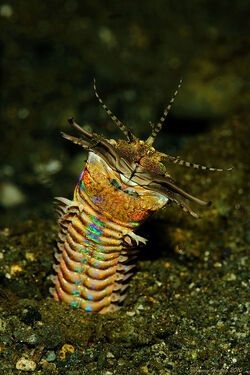| Bobbit Worm | |
|---|---|
 | |
| Information | |
| Range | Indo-Pacific and Atlantic Ocean |
| Scientific Classification | |
| Kingdom | Animalia |
| Phylum | Annelida |
| Class | Polychaeta Palpata |
| Order | Eunicida |
| Family | Eunicidae |
| Genus | Eunice |
| Species | Eunice aphroditois |
The Bobbit worm (Eunice aphroditois), is a species of aquatic predatory polychaete dwelling at the ocean floor. This organism buries its long body into an ocean bed composed of gravel, mud, or corals, where it waits patiently for a stimulus to one of its five antennae, attacking when it senses prey. Armed with sharp teeth, it is known to attack with such speeds, its prey is sometimes sliced in half. Although the worm hunts for food, it is omnivorous.
According to Luis F. Carrera-Parra and Sergio I. Salazar-Vallejo, ecologists specializing in annelid polychaetes at El Colegio de la Frontera Sur in Campeche, Mexico, eunicids inject "... narcotizing or killing toxin in their prey animal, such that it can be safely ingested — especially if they are larger than the worm — and then digested through the gut". They further state, unlike a different family of worms, the fireworms, which have harpoon-shaped chaetae (bristles) that release a toxin that can cause severe skin irritation, bobbit worm specimens "do not have abundant chaetae and their chaetae are not used for defensive purposes, but for improving traction for crawling over the sediment or inside their galleries or tubes".
Little is known about the sexual habits and lifespan of this worm, but researchers hypothesize that sexual reproduction occurs at an early stage, maybe even when the worm is about 100 mm (3.9 in) in length; this is very early, considering these worms can grow to sizes of nearly 3 m (9.8 ft) in some cases (although most observations point to a much lower average length of 1 m (3 ft 3 in) and an average of 25 mm (0.98 in) in diameter). A long lifespan may very well explain the size of these creatures.
The bobbit worm is found in warmer oceans around the world, including the Indo-Pacific and Atlantic Ocean.
In Aquaria[]
Bobbit worms may be accidentally introduced into artificial environments. In March 2009, the Blue Reef Aquarium in Newquay, Cornwall, discovered a Bobbit worm in one of their tanks. The workers had seen the devastation caused by the worm, such as fish being injured or disappearing and coral being sliced in half, but did not find it until they started taking the display apart in the tank. The worm was nicknamed "Barry".
Another Bobbit worm, three and a half feet long and a few inches thick, was found October 7th, 2013 in Maidenhead Aquatics in Woking, Surrey.
Videos[]

Giant Sea Worm - Bobbit Worm
